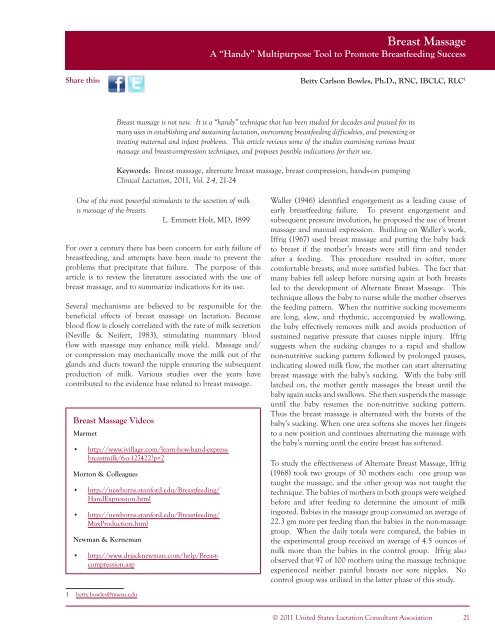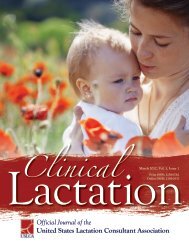Breast Massage - Clinical Lactation
Breast Massage - Clinical Lactation
Breast Massage - Clinical Lactation
Create successful ePaper yourself
Turn your PDF publications into a flip-book with our unique Google optimized e-Paper software.
<strong>Breast</strong> <strong>Massage</strong>A “Handy” Multipurpose Tool to Promote <strong>Breast</strong>feeding SuccessShare this:Betty Carlson Bowles, Ph.D., RNC, IBCLC, RLC 1<strong>Breast</strong> massage is not new. It is a “handy” technique that has been studied for decades and praised for itsmany uses in establishing and sustaining lactation, overcoming breastfeeding difficulties, and preventing ortreating maternal and infant problems. This article reviews some of the studies examining various breastmassage and breast-compression techniques, and proposes possible indications for their use.Keywords: <strong>Breast</strong> massage, alternate breast massage, breast compression, hands-on pumping<strong>Clinical</strong> <strong>Lactation</strong>, 2011, Vol. 2-4, 21-24One of the most powerful stimulants to the secretion of milkis massage of the breasts.L. Emmett Holt, MD, 1899For over a century there has been concern for early failure ofbreastfeeding, and attempts have been made to prevent theproblems that precipitate that failure. The purpose of thisarticle is to review the literature associated with the use ofbreast massage, and to summarize indications for its use.Several mechanisms are believed to be responsible for thebeneficial effects of breast massage on lactation. Becauseblood flow is closely correlated with the rate of milk secretion(Neville & Neifert, 1983), stimulating mammary bloodflow with massage may enhance milk yield. <strong>Massage</strong> and/or compression may mechanically move the milk out of theglands and ducts toward the nipple ensuring the subsequentproduction of milk. Various studies over the years havecontributed to the evidence base related to breast massage.<strong>Breast</strong> <strong>Massage</strong> VideosMarmet• http://www.ivillage.com/learn-how-hand-expressbreastmilk/6-a-127422?p=2Morton & Colleagues• http://newborns.stanford.edu/<strong>Breast</strong>feeding/HandExpression.html• http://newborns.stanford.edu/<strong>Breast</strong>feeding/MaxProduction.htmlNewman & Kerneman• http://www.drjacknewman.com/help/<strong>Breast</strong>compression.aspWaller (1946) identified engorgement as a leading cause ofearly breastfeeding failure. To prevent engorgement andsubsequent pressure involution, he proposed the use of breastmassage and manual expression. Building on Waller’s work,Iffrig (1967) used breast massage and putting the baby backto breast if the mother’s breasts were still firm and tenderafter a feeding. This procedure resulted in softer, morecomfortable breasts, and more satisfied babies. The fact thatmany babies fell asleep before nursing again at both breastsled to the development of Alternate <strong>Breast</strong> <strong>Massage</strong>. Thistechnique allows the baby to nurse while the mother observesthe feeding pattern. When the nutritive sucking movementsare long, slow, and rhythmic, accompanied by swallowing,the baby effectively removes milk and avoids production ofsustained negative pressure that causes nipple injury. Iffrigsuggests when the sucking changes to a rapid and shallownon-nutritive sucking pattern followed by prolonged pauses,indicating slowed milk flow, the mother can start alternatingbreast massage with the baby’s sucking. With the baby stilllatched on, the mother gently massages the breast until thebaby again sucks and swallows. She then suspends the massageuntil the baby resumes the non-nutritive sucking pattern.Thus the breast massage is alternated with the bursts of thebaby’s sucking. When one area softens she moves her fingersto a new position and continues alternating the massage withthe baby’s nursing until the entire breast has softened.To study the effectiveness of Alternate <strong>Breast</strong> <strong>Massage</strong>, Iffrig(1968) took two groups of 30 mothers each: one group wastaught the massage, and the other group was not taught thetechnique. The babies of mothers in both groups were weighedbefore and after feeding to determine the amount of milkingested. Babies in the massage group consumed an average of22.3 gm more per feeding than the babies in the non-massagegroup. When the daily totals were compared, the babies inthe experimental group received an average of 4.5 ounces ofmilk more than the babies in the control group. Iffrig alsoobserved that 97 of 100 mothers using the massage techniqueexperienced neither painful breasts nor sore nipples. Nocontrol group was utilized in the latter phase of this study.1 betty.bowles@mwsu.edu© 2011 United States <strong>Lactation</strong> Consultant Association 21
To facilitate milk removal with minimal sucking effort for:To maximize breastfeeding when there are negative effectsfrom:ReferencesAyers, J.F. (2000). The use of alternative therapies in the support ofbreastfeeding. Journal of Human <strong>Lactation</strong>, 16(1), 52-56.Bowles, B.C., Stutte, P.C., & Hensley, J.H. (December 1987/January 1988).New benefits from an old technique: Alternate massage in breastfeeding.Genesis (ASPO/Lamaze), 9(6), 5-9, 17.Foda, M.I., Kawashima, T., Nakamura, S., Kobayashi, M., & Oku, T. (2004).Composition of milk obtained from unmassaged versus massaged breastsof lactating mothers. Journal of Pediatric Gastroenterology and Nutrition, 38,484-487.Foda, M.I., & Oku, T. (2008). Changes in milk protein of lactating mothersfollowing breast massage. International Journal of Dairy Science, 3(2), 86-92.Holt, L.E. (1899).The diseases of infancy and childhood. New York: D. Appletonand Company.Iffrig, M.C. (1967). Early breastfeeding with alternate massage. InternationalJournal of Nursing Studies, 4, 193-200.Iffrig, M.C. (1968). Nursing care and success in breastfeeding. Nursing Clinicsof North America, 3(2), 345-354.Jones, E., Dimmock, P.W., & Spencer, S.A. (2004). A randomized controlledtrial to compare methods of milk expression after preterm delivery.Archives of Diseases of Children Fetal Neonatal Education, 85, F91-F95.Marmet, C. (1999). Learn how to hand express breast milk. Retrieved from http://www.ivillage.com/learn-how-hand-express-breastmilk/6-a-127422?p=2Matthiesen, A.S., Ransjo-Arvidson, A.B., Nissen, E., & Uvnas-Moberg, K.(2001). Postpartum maternal oxytocin release by newborns: Effects ofinfant hand massage and sucking. Birth, 28(1), 13-19.Sore nipplesCraniofacial abnormalitiesNeurological defectsCardiorespiratory impairmentsHormonal contraceptionSmokingSupplementationSkipped feedings or baby sleeping all nightReturn to employmentNipple shield useHemorrhage or anemiaRetained placental fragmentsMorton, J., Hall, J.Y., Wong, R.J., Thairu, L., Benitz, W.E., & Rinne, W.D.(2009). Combining hand techniques with electric pumping increased milkproduction in mothers of preterm infants. Journal of Perinatology, 29, 757-764.Morton, J. (2009a). Hand expression of breast milk. Retrieved from http://newborns.stanford.edu/<strong>Breast</strong>feeding/HandExpression.htmlMorton, J. (2009b). Maximizing milk production with hands on pumping. Retrievedfrom http://newborns.stanford.edu/<strong>Breast</strong>feeding/MaxProduction.htmlNeville, M.C., & Neifert, M.R. (1983). <strong>Lactation</strong>: Physiology, nutrition, andbreastfeeding. New York: Plenum Press.Newman, J., & Kernerman, E. (2008). <strong>Breast</strong>feeding help: <strong>Breast</strong> compression.Retrieved from http://www.drjacknewman.com/help/<strong>Breast</strong>-compression.aspStorr, G.B. (1987). Prevention of nipple tenderness and breast engorgement inthe postpartal period. Journal of Obstetric, Gynecologic, and Neonatal Nursing,15, 203-209.Stutte, P.C., Bowles, B.C., & Morman, G.Y. (April/May 1988). The effects ofbreast massage on volume and fat content of human milk. Genesis (ASPO/Lamaze), 10(2), 22-25.Waller, H. (1946). The early failure of breastfeeding. Archives of Diseases ofChildhood, 21, 1-12.Yokoyama, Y., Ueda, T., Irahara, M., & Aono, T. (1994). Releases of oxytocinand prolactin during breast massage and suckling in puerperal women.European Journal of Obstetrics & Gynecology & Reproductive Biology, 53, 17-20.U.S. <strong>Breast</strong>feeding Committee published a new Statement on Infant/Young Child Feeding in Emergencies.24 <strong>Clinical</strong> <strong>Lactation</strong> 2011, Vol. 2-4 Electronic version of this issue is available at www.<strong>Clinical</strong><strong>Lactation</strong>.org




